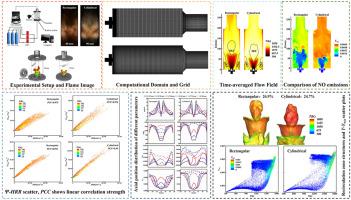Effects of combustor geometry on NH3–CH4 swirling turbulent premixed flames: a combined experimental and large eddy simulation analysis of combustion dynamics and NO emissions
IF 8.3
2区 工程技术
Q1 CHEMISTRY, PHYSICAL
引用次数: 0
Abstract
Ammonia is a promising zero-carbon fuel for gas turbines but is often blended with methane to enhance combustion. This study investigates the previously unexplored influence of combustor geometry on ammonia-methane premixed swirling flames. Experiments and large eddy simulations (LES) were conducted at an equivalence ratio of 0.85 for a blend of 70 vol% NH3 and 30 vol% CH4, comparing rectangular and cylindrical combustors. The results show distinct flame stabilization mechanisms: wall confinement in the rectangular combustor creates fragmented recirculation zones, whereas the cylindrical geometry promotes a coherent swirling flow. Consequently, the cylindrical combustor generated 1.8 × higher NO emissions (experimentally 2045 ppm vs 1127 ppm), attributed to increased OH radical concentration and higher post-flame temperatures that inhibit NO reduction. These findings suggest rectangular combustors can better balance flame stability with reduced emissions under the studied conditions, providing valuable guidance for designing advanced low-NOx combustors using ammonia fuel blends.

燃烧室几何形状对NH3-CH4旋转湍流预混火焰的影响:燃烧动力学和NO排放的实验和大涡模拟分析
氨是一种很有前途的燃气轮机零碳燃料,但通常与甲烷混合以增强燃烧。本研究探讨了以前未被探索的燃烧室几何形状对氨-甲烷预混旋转火焰的影响。在70 vol% NH3和30 vol% CH4混合物的等效比为0.85的条件下,对矩形燃烧室和圆柱形燃烧室进行了实验和大涡模拟(LES)。结果显示了不同的火焰稳定机制:矩形燃烧室的壁面限制产生了破碎的再循环区,而圆柱形几何结构则促进了连贯的旋流。因此,圆柱形燃烧器产生的NO排放量增加了1.8倍(实验结果为2045 ppm vs 1127 ppm),这是由于OH自由基浓度的增加和火焰后温度的升高抑制了NO的还原。这些发现表明,在研究条件下,矩形燃烧器可以更好地平衡火焰稳定性和减少排放,为设计使用氨燃料混合物的先进低nox燃烧器提供了有价值的指导。
本文章由计算机程序翻译,如有差异,请以英文原文为准。
求助全文
约1分钟内获得全文
求助全文
来源期刊

International Journal of Hydrogen Energy
工程技术-环境科学
CiteScore
13.50
自引率
25.00%
发文量
3502
审稿时长
60 days
期刊介绍:
The objective of the International Journal of Hydrogen Energy is to facilitate the exchange of new ideas, technological advancements, and research findings in the field of Hydrogen Energy among scientists and engineers worldwide. This journal showcases original research, both analytical and experimental, covering various aspects of Hydrogen Energy. These include production, storage, transmission, utilization, enabling technologies, environmental impact, economic considerations, and global perspectives on hydrogen and its carriers such as NH3, CH4, alcohols, etc.
The utilization aspect encompasses various methods such as thermochemical (combustion), photochemical, electrochemical (fuel cells), and nuclear conversion of hydrogen, hydrogen isotopes, and hydrogen carriers into thermal, mechanical, and electrical energies. The applications of these energies can be found in transportation (including aerospace), industrial, commercial, and residential sectors.
 求助内容:
求助内容: 应助结果提醒方式:
应助结果提醒方式:


